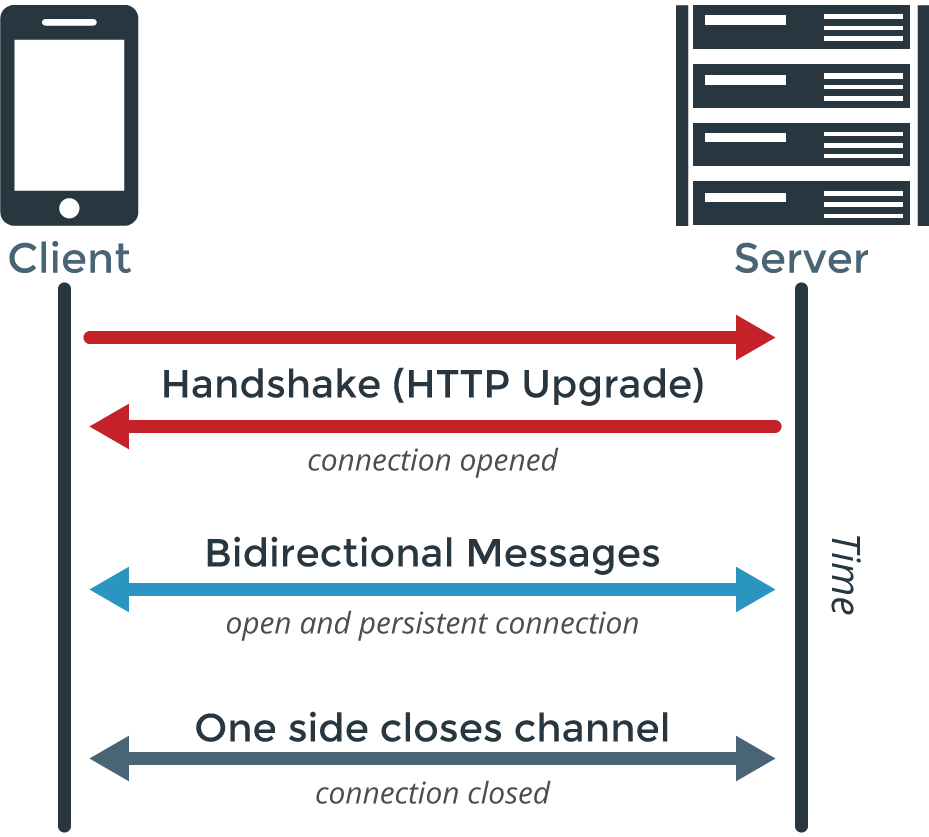-
Notifications
You must be signed in to change notification settings - Fork 14
What are Websockets
The Websockets Protocol is a way for clients and servers to exchange Messages over TCP in a known, common way. It is essentially a thin standard above raw TCP communication.
A typical Websockets communication consists of 2 Endpoints, a Client and a Server. Before Endpoints can communicate they must perform an handshake and negotiate over the protocol's Version, the usage of Sub-Protocols and more. The handshake is an important step in the communication, but will not be covered here as it is very low-level. You can read more about the proccess here.

Credit: taken from an article by Thilina Ashen Gamage
This section should help you understand the basics of Websockets and hopefully, help you get started with the library better.
Note: This section only refers to version 13 of the protocol as described in RFC-6455.
A Websockets Message is composed of Frames where a Frame is a single transaction between the 2 connected endpoints. Every Frame has a Header and a Payload.
Every Frame has a type associated with it represented as a 4-bit opcode. A frame can be either a Control Frame or a part of a Data Message (type is deduced from the opcode field).
A Frame may also have a payload (body). The payload field for a standard Data Frame can be up to 2^64 bytes long.
Control Frames are always composed of a single Frame and have a type associated with them. Control Frames are used to communicate state about the connection, to check the other's endpoint availability or close the connection.
Control Frames may have payload (body) with length of up to 125 bytes.
The standard Control Frame types are: Ping, Pong and Close.
The Close frame contains an opcode of 0x8 and may include a payload that indicates the reason for closing the connection.
The closing-side must not send any more messages after sending a Close frame. The receiving-side should send a Close frame and then close the connection.
Close can be sent for several reasons: internal error, protocol error, or a user-initiated close (to name a few).
The Ping frame contains an opcode of 0x9 and may include a payload.
Upon receipt of a Ping frame, a Websockets Endpoint must send a Pong frame with the same payload of the received Ping frame.
The Pong frame contains an opcode of 0xA and according to the specification, should be sent "as soon as practical".
A Ping frame may serve either as a keepalive or as a means to verify that the remote endpoint is still responsive.
A data frame is either of type Text (opcode: 0x1) or Binary (opcode: 0x2). The payload field for a standard Data Frame can be up to 2^64 bytes long.
While Data Frames are what going back and forth between one Websockets Endpoint and another, at the application level the programmer should only really care for Messages.
Messages are composed of frames. A Message can be contained of a single Data Frame (by default). A Message can also be fragmented so it will be sent as a continuous sequence of Fragments. Fragments are just Data Frames marked as partial (with opcode: 0x0, and some other rules).
By default, the user will only handle Messages and should not care about Fragments. Fragments become usefull when there is a need to stream content or, send it in chuncks and interpret it as a single and complete Message.
Data Frames in general have no default action associated with them (unlike Control Frames), and are completly at the Application's level.
Text data-frameswill have the opcode field set to 0x1 and the payload field will contain only data encoded as UTF-8.
Binary data-frames will have the opcode field set to 0x2 and the payload field will contain arbitrary binary data whose interpretation is solely up to the application layer.
Written by Gil Maimon @ 2019